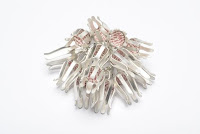 In the Rebecca's latest photography exhibition Failing, Falling, Flying, I saw a series of inkjet print photographs which are express absurd. When I was looking at these photographs from left to right, I noticed that each of them talks about a different life scene. One step closer, I found these are all some freezing moment. The one called Spin, it looks like a man is rolling down from the stairs on the mountain. Other one which is next to Spin is called Jump, a black person with red shirt is jumping from a wood block to the sea. Interestingly, this jumping action is filmed. It looks like a humorous video is paused and the frame is stick. Honestly speaking, I don't quite understand these photographs at the beginning. They are all seem like some freezing moment, people's actions are paused but looks weird.
In the Rebecca's latest photography exhibition Failing, Falling, Flying, I saw a series of inkjet print photographs which are express absurd. When I was looking at these photographs from left to right, I noticed that each of them talks about a different life scene. One step closer, I found these are all some freezing moment. The one called Spin, it looks like a man is rolling down from the stairs on the mountain. Other one which is next to Spin is called Jump, a black person with red shirt is jumping from a wood block to the sea. Interestingly, this jumping action is filmed. It looks like a humorous video is paused and the frame is stick. Honestly speaking, I don't quite understand these photographs at the beginning. They are all seem like some freezing moment, people's actions are paused but looks weird.Through a more particular knowledge of it, I understand these pictures are talking about absurd
 and Rebecca composed the animated sence in mid-flight, mid-jump or mid-vomit. Why I didn't realise at first time I saw them? By reading Peter Shand’s essay I’m Walking Backwards for Christmas, it gives me a better understanding in Rebecca's work. The essay gives a little bit of explanations of the work Spin. It says" the stuntman seems to tumble backward down the zigzagging stairway, this misfortune and the risk of injury painfully apparent". It says this is a type of humour and the amusement comes from the stuntman or the misfortune.
and Rebecca composed the animated sence in mid-flight, mid-jump or mid-vomit. Why I didn't realise at first time I saw them? By reading Peter Shand’s essay I’m Walking Backwards for Christmas, it gives me a better understanding in Rebecca's work. The essay gives a little bit of explanations of the work Spin. It says" the stuntman seems to tumble backward down the zigzagging stairway, this misfortune and the risk of injury painfully apparent". It says this is a type of humour and the amusement comes from the stuntman or the misfortune.I like the way how Rebecca represent the word "absurd". The absurd things on the photographs is very visible, concise and viewer don't have to spend a plenty of time on thinking about what this on the photo or making viewer feel abstract. These absurd events are not for making people laugh all the time because they are not comedy or comic book. When we looking at the stuntman, we will laugh at the silly thing which is just about to happen and the injury must be serious. And at the same time, we also will pay more attention on our daily life after we saw the photos. Because the next person who probably will fall down from stairs is you. Most of the absurd things happened in Rebecca's works are very close to our daily life.

In Peter Shand’s essay, it also says" that Hobbs's work is devoid of irony, that it's consciously generous and sincere" It is true that there are many artworks represent humour with irony, like the political cartoon we can frequently see on newspaper or some pictures about irony popular on the Internet. However, in my opinion, irony is not the main thing Rebecca wants to talk about. The humour in the works comes from reality and our genuine life. Everyone has the possibility of making silly or absurd things. So, in general, Rebecca's work is try to use genuine humour represent absurdity.


.jpg)
.jpg)